Class 10 Science: CBSE Sample Question Paper (2019-20) - 6 | Science Class 10 PDF Download
Class-X
Science-086
SAMPLE QUESTION PAPER 2019-20
TIME: 3 Hrs.
M.M: 80
General Instructions:
1. The question paper comprises three sections - A, B and C. Attempt all the sections.
2. All questions are compulsory.
3. Internal choice is given in each section.
4. All questions in Section A are one - mark questions comprising MCQ, VSA type and
assertion-reason type questions. They are to be answered in one word or in one sentence.
5. All questions in Section B are three - mark, short - answer type questions. These are to be answered in about 50 - 60 words each.
6. All questions in Section C are five - mark, long - answer type questions. These are to be answered in about 80 - 90 words each.
7. This question paper consists of a total of 30 questions.
Section A
Q.1. If two elements X and Y are present on the left and right side of the same group in the periodic table, then the atomic size of X would be more than that of Y. Examine the given statement and justify your answer. (1 Mark)
Ans: Atomic radius decreases across a period because electron is added in the same shell. So, attraction between nucleus and valence shell electrons increases due to which outermost shell is pulled in closer to the nucleus. Therefore, if two elements are present on the left (X) and right side (Y) of the periodic table in the same period, then the atomic size of the element present on the left would be greater than that of the element present on the right.
Q.2. A wire of resistance 8 Ω is bent in the form of a closed circle. What is the effective resistance between the two points A and B, at the ends of any diameter of the circle ? (1 Mark) 
(a) 8 Ω
(b) 4 Ω
(c) 2 Ω
(d) 1 Ω
Ans: (c) When a wire of 8 a resistance is bent in the form of a closed circle, resistance of each half (semicircular) part is 8/2 Ω = 4Ω. As these two parts are connected in parallel across points A and B, hence effective resistance will be 2 Ω.
Q.3. Answer question numbers 3(a) - 3(d) on the basis of your understanding of the following paragraph and the related studied concepts.
Operating on the same principle as wind turbines, the power in sea turbines comes from tidal currents, which turn blades similar to ships' propellers, but, unlike wind, the tides are predictable and the power input is constant. The technology raises the prospect of many countries becoming self-sufficient in renewable energy and drastically reducing its carbon dioxide emissions. If tide, wind and wave power are all developed, Britain would be able to close gas, coal and nuclear power plants and export renewable power to other parts of Europe. Unlike wind power, which Britain originally developed and then abandoned for 20 years allowing the Dutch to make it a major industry, undersea turbines could become a big export earner to island nations such as Japan and New Zealand.
(a) On what principle do the sea turbines operate? (1 Mark)
(b) What is the advantage of sea turbines over wind turbines? (1 Mark)
(c) If tide, wind and wave power are used by Britain which other energy sources are likely to be closed by it? (1 Mark)
(d) For which countries sea turbines can become a good source of energy? (1 Mark)
Ans: (a) Wind turbines.
(b) Unlike the wind the tides are predictable hence, power input is constant. (c) Gas, coal and nuclear plants.
(d) Japan and New Zealand.
Q.4. For Q. Nos. 4(i)-4(iv) are based on the information given below. Study these information related to answer the questions that follow :
Resistance of a conductor depends on the length, area of cross-section and nature of the material of the conductor. When a conductor is stretched (increased in its length), then its area of cross-section decreases accordingly but the volume (i.e. area x length) of the conductor remains same.
(i) Define resistivity of a conductor. (1 Mark)
(ii) The SI unit of resistivity is (1 Mark)
(a) ohm (Ω)
(b) ohm-metre (Ω - meter)
(c) ohm2 - metre (Ω2 - m)
(d) ohm-metre2 (Ω - m2)
(iii) Write one difference between resistance and resistivity. (1 Mark)
(iv) The resistance (R) of a wire of length is halved and area of cross-section (A) is doubled, its new resistance (R') will be (1 Mark)
(a) R
(b) R/2
(c) R/4
(d) R/5
Ans: (i) Resistivity is defined as the resistance of a conductor of unit length and unit area of cross-section.
(ii) (b) SI unit of resistivity is ohm-metre.
(iii) Resistance is that property of a conductor by virtue of which it opposes or resists the flow of charges through it. Its SI unit Ω.
Resistivity is the characteristic property of the material of the conductor and varies only if its temperature changes. Its SI unit Ω-metre
(iv) (c) 

Q.5. Which is the weakest base out of the following ? (1 Mark)
(a) Sodium hydroxide
(b) Potassium hydroxide
(c) Ammonium hydroxide
(d) Magnesium hydroxide
Ans: (c) Ammonium hydroxide
Q.6. A piece of wire of resistance R is cut into five equal parts. These parts are then connected in parallel. If the equivalent resistance of this combination is R', then the ratio R/R' is (1 Mark)
(a) 1/25
(b) 1/5
(c) 5
(d) 25
Ans: (d) 25
Q.7. If a live wire and neutral wire come in contact either directly or via conducting wire, then the situation is called (1 Mark)
(a) overloading
(b) short circuiting
(c) sparking
(d) open circuiting
Ans: (b) When the live wire and neutral wire come in contact either directly or via conducting wire, then this situation is called short circuiting.
Q.8. A feature of reproduction that is common to Malarial parasite, Spirogyra and Yeast is that (1 Mark)
(a) they all are multicellular.
(b) they all reproduce sexually only.
(c) they reproduce asexually.
(d) they all are unicellular.
Ans: (c) In all of them asexual reproduction takes place e.g., in spirogyra fragmentation, malarial parasite multiple fission and in yeast by budding.
Q.9. Chlorine reacts with saturated hydrocarbons at room temperature in the: (1 Mark)
(a) absence of sunlight
(b) presence of sunlight
(c) presence of water
(d) presence of hydrochloric acid
Ans: (b)
Q.10. Which one is not a base? (1 Mark)
(a) NaOH
(b) HNO3
(c) Ca(OH)2
(d) NH4OH
Or
The solution with the lowest concentration of H+ ions is
(a) pH = 7
(b) pH = 8.6
(c) pH =6.8
(d) pH =2.0
Ans: (b) NaOH, Ca(OH)2 and NH4OH are the examples of a base while HNO3 is an acid. A base gives OH- ion in the presence of water.
Or
(b) The solution with pH more than 7 are basic in nature hence, solution with pH = 8.6 has less concentration of H+ and more concentration of OH-.
Q.11. An electric iron of 750 W rating is used for 20 hours. The amount of electrical energy consumed is __________ units. (1 Mark)
Ans: 
Q.12. The order of decreasing atomic size is: (1 Mark)
(a) Na < Mg < Al < Si
(b) Na > Mg > Al > Si
(c) Mg < Na < Al < Si
(d) Mg > Na > Al > Si
Or
The element with atomic number 18 belongs to which group:
(a) Halogens
(b) Alkali metals
(c) Alkaline earth metals
(d) Noble gases.
Ans: (a) Or (d)
Q.13. In each of the following questions, a statement of Assertion is given by the corresponding statement of Reason. Of the statements, mark the correct answer as (1 Mark)
(a) If both Assertion and Reason are true and Reason is the correct explanation of Assertion.
(b) If both Assertion and Reason are true, but Reason is not the correct explanation of Assertion.
(c) If Assertion is true, but Reason is false.
(d) If Assertion is false, but Reason is true.
Assertion: Acetic acid acts as an acid in benzene solution.
Reason: Benzene accepts proton.
Ans: (d) A substance acts as an acid (i.e. gives a proton) only when another substance present acts as a base (i.e. accepts a proton). CH3COOH cannot act as an acid in benzene because benzene cannot accept a proton (i.e. cannot act as a base).
Q.14. Knowing the electronic configuration, we can find the valency of the element. (1 Mark)
Ans: True.
Section B
Q.15. State the differences between the sperm and ovum. (3 Mark)
Ans: The differences between sperm and ovum are as follows
Q.16. Two lamps, one rated 100 W at 220 V and the other 200 W at 220 V are connected (i) in series and (ii) in parallel to electric main supply of 220 V. Find the current drawn in each case. (3 Mark)
Ans: As per question for first lens P1 = 100 W and V1 = 220 V, hence its resistance
For second lens P2 = 200 W and V2 = V 1 = 220 V. Hence its resistance
(i) In series arrangement, total resistance Rs = R1 + R2 = 484 + 242 = 726 Ω
(ii) In parallel arrangement, total resistance Rp is given as :
⇒ 

Q.17. The modem periodic table has been evolved through the early, attempts of Dobereiner, Newland and Mendeleev. List one advantage and one limitation of all the three attempts. (3 Mark)
Ans: 
Q.18. (i) How much work is done in moving a charge of 3C across two points having a potential difference 15V?
(ii) Find the equivalent resistance between A and B. (3 Mark)
Ans: (i) Given, charge, q = 3C, potential difference, ΔV = 15 V
The amount of work done in moving the charge
W = Vq = 15 x 3 = 45 J
(ii) Equivalent resistance between A and B is given by
Q.19. What happens when aqueous solutions of Sodium sulphate and Barium chloride are mixed ? Give a balanced equation for the reaction with state symbols.
Name and define the type of chemical reaction involved in the above change. (3 Mark)
Ans: A white precipitate of barium sulphate is obtained.
Na2SO4 (aq) + BaCl2 (aq) → 2NaCl (aq) + BaSO4(↓)
It is a double displacement reaction.
A reaction in which there is an exchange of ions between the reactants is called double displacement reaction.
Q.20. Mention three important features of fossils which help in the study of evolution. (3 Mark)
Ans: (a) Fossils represent modes of preservation of ancient species.
(b) Fossils help in establishing evolutionary traits among organisms and their ancestors.
(c) Fossils help in establishing the time period in which organisms lived.
Q.21. Analyse the following given statements and present your views on the same. (3 Mark)
(i) Parthenogenesis is not the same as asexual reproduction.
(ii) The male reproductive system is also called the urinogenital system.
Ans:
(i) Parthenogenesis is different from asexual reproduction. In parthenogenesis, an individual develops from an unfertilised egg. In contrast, in asexual reproduction, a single parent gives rise to new individuals without the fusion of gametes and the offspring have the same genes as that of the parent.
(ii) The male reproductive system has only one opening for both urine and semen. The vas deferens unite with a duct coming from the urinary bladder to form the urethra. This structure, enclosed within the thick, muscular penis, opens through a pore and serves as the common passage for both sperms and urine. Thus, the human male reproductive system is also called as the urinogenital system.
Q.22. Pertaining to endocrine system, what will you interpret if
(i) you observe swollen neck in people living in the hills.
(ii) over secretion of growth hormone takes place during childhood.
(iii) facial hair develops in boys aged 13. (3 Mark)
Ans: (i) Presence of swollen neck in people living in hills indicates enlargement of thyroid gland. This is due to deficiency of iodine in their diet which leads to less production of thyroxine, for which thyroid gets enlarged. This is also called Goitre.
(ii) Over secretion of growth hormone in childhood leads to large body and is called Gigantism.
(iii) Facial hair in boys aged 13 is onset of Puberty.
Q.23. It is established that an electric current through a metallic conductor produces a magnetic field around it. Is there a similar magnetic field produced around a thin beam of moving (i) alpha particles, (ii) neutrons? Justify your answer. (3 Mark)
Ans: (i) Yes, Alpha particles being positively charged constitutes a current in the direction of motion.
(ii) No. The neutrons being electrically neutral constitute no current
Q.24. When magnetic field lines are drawn around a current carrying circular loop, it has been observed that they are close to its axis. But these lines keeps on diverging as we move away from the centre. Explain this observation.
Ans: We know that, magnetic field is stronger near the current carrying conductor and weaker as we move away from conductor. In case of a current carrying circular loop, the magnetic field is weaker near the periphery but stronger near the centre of the loop. Due to this, the magnetic field lines appear as straight lines near the centre.
As we move towards the periphery of the circular loop, the magnetic field lines appear to be diverging, so that they can be circular around the wire of the loop. (3 Mark)
Section C
Q.25. ‘We all use various forest produce. But our dependency on forest resources varies. Some of us have access to alternatives and some do not. Evaluate the statement with regards to stakeholders.
Or
‘Dams are the barriers constructed across the rivers to hold the water. These ensure the storage of adequate water for different uses'. Still large dams are criticised. Why? (5 Mark)
Ans: A stakeholder can be a person, a group or an organisation that may be affected or have any kind of interest in the project or in the project’s outcome either directly or indirectly. All stakeholders are not equal, every stakeholder has his own expectations and requirements that should be handled according to the way he expects.
When we consider the conservation of forests, we need to look at the stakeholders who are
(i) The Local People These are the people who live in or around the forests and are dependent on the forest products for various aspects of their life. They need large quantities of firewood, small timber and thatch (craft for building roof). In addition to people gathering fruits, nuts and medicines from the forests, their cattle also graze in forest areas or feed on other fodder which is collected from forests.
(ii) The Forest Department This department controls the resources obtained from the forests. The officials of this department tend to ignore both local knowledge and local needs in their management practices. Thus, vast tracts of forests have been converted to monocultures of pine or Eucalyptus. Such plantations are useful for the industries to access specific products and are an important source of revenue for the Forest Department.
(iii) Industries These consider the forest as merely a source of raw materials and huge interest groups lobby the government for access to these raw materiais at extremely low rates.
(iv) The Nature and Wildlife Enthusiasts The wildlife and nature enthusiasts are those who want to conserve nature in its pristine form. They are not dependent on forests. The conservationist first started conserving large animals like lions, tigers, elephants and rhinoceros. But, they now recognise the need to preserve biodiversity as a whole.
Or
Dams are the barriers constructed across rivers to hold the water. These are large reservoirs of water which ensure the storage of adequate water for different uses.
Water stored in dams can be used for different purposes such as
- For irrigation:
- For the generation of electricity (hydroelectric power).
- To control floods as dams store water during rainy season.
- Supply of water over a large distance (to the place where required) through the canal system, e.g.
Indira Gandhi Canal has brought greenery to considerable areas of Rajasthan.
Large dams cause following three problems in particular
(i) Social problems because they displace large number of peasants and tribals without enough compensation or rehabilitation.
(ii) Economic problems because they utilise a large amount of public money without the generation of proportionate benefits.
(iii) Environmental problems because they contribute enormously to deforestation which leads to the loss of biological diversity.
Mismanagement of water distribution has largely led to the benefits being taken by a few people only. There is no equal distribution of water. People close to water reservoirs grow water intensive crops like sugarcane and rice, while people farther downstream do not get any water. The natives who have been promised benefits that never arrived add to the discontented list of people who have been displaced due to building of dams and their canal network.
Q.26. (i) With the help of an activity, explain the method of inducing electric current in a coil with a moving magnet. State the rule used to find the direction of electric current thus generated in the coil.
(ii) Two circular coils-1 and coil-2 are kept close to each other as shown in the diagram. Coil-1 is connected to a battery and key and coil-2 with a galvanometer.
State your observation in the galvanometer :
(a) when key K closed;
(b) when key K is opened.
Give reason for your observations. (5 Mark)
Ans: (i) Take a coil AB of insulated copper wire having a number of turns. Connect the ends of coil to a sensitive galvanometer G. Now take a bar magnet NS and rapidly bring the magnet towards the end B of coil as shown in figure.
The galvanometer gives momentary deflection in one direction. Now take the magnet away from the coil, the galvanometer again gives momentary deflection but in the opposite direction. It clearly shows that motion of magnet induces, a current in the coil.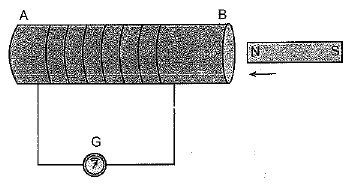
Direction of induced current is given by Fleming’s right-hand rule. Fleming’s right-hand rule states that hold the forefinger, the central finger and the thumb of the right-hand mutually perpendicular to each other such that the forefinger indicates the direction of magnetic field and the thumb is in the direction of motion of a conductor. Then, the central finger shows the direction of current induced in the conductor.
(ii) (a) When key K is closed, magnetic field in coil 2 increases and an induced current is produced in coil 2. As a result, the galvanometer gives a momentary deflection in one direction.
(B) When key K is opened, magnetic field in coil 2 decreases and again an induced current is produced in coil 2, whose direction is opposite to that obtained in (a). Hence, the galvanometer gives a momentary deflection in the reverse direction.
Or
Name a device which converts mechanical energy into electrical energy. Explain the underlying principle and working of this device with the help of a labelled diagram.
Ans: An electric generator converts mechanical energy into electrical energy.
Principle : An electric generator works on the principle of electromagnetic induction phenomenon. According to it, whenever a coil is rotated between the poles of a magnet, an induced current is set up in the coil, whose direction is given by Fleming’s right-hand rule.
Working : Let in the beginning, as shown in figure brushes B1 and B2 are kept pressed separately on rings R1 and R2 respectively. Let the axle attached to the rings is rotated such that arm AB of the coil moves up and arm CD moves down in the magnetic field. Due to rotation of arms AB and CD induced currents are set up in them. As per Fleming’s right-hand rule induced currents in these arms are along the directions AB and CD respectively. Thus, an induced current flows along ABCD and current in the external circuit flows from B2 to B1.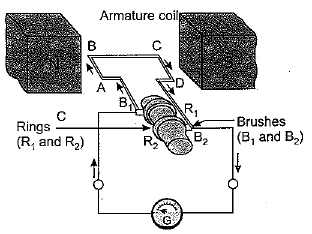
After half a rotation, arm AB starts moving down and the arm CD upward. Therefore, directions of induced currents in these arms change. Thus, net induced current now becomes in the direction DCBA. In the external circuit now current flows from B1 to B2. Thus, after every half rotation current changes its direction and an alternating current is obtained from the generator.
Action of brushes : Brushes are kept pressed on the two slip rings separately. Outer ends of the brushes are connected to the galvanometer (or the external load). Thus, brushes help in transferring current from the coil ABCD to the external circuit.
Q.27. (a) Why is diffusion insuffident to meet the oxygen requirements of multicellular organisms like humans ?
(b) What criteria do we use to decide whether something is alive ? (5 Mark)
Ans: (a) In the multicellular organisms, all the cells may not be in direct contact with the surrounding environment. Therefore, the diffusion is insufficient to meet the oxygen requirements in them. Instead, they need specialised organs for breathing and exchange of gases. (b) The following criteria is taken into account before deciding whether a thing is alive or not :
(i) All living things breathe.
(ii) All living things grow.
(iii) All those things which are green and growing are also living.
(iv) All living things repair and reproduce.
(v) All living things have a definite lifespan.
(vi) All living things have ability to evolve.
(vii) All living things have the ability to convert simple things into complex things.
(viii) Most of the living things has the ability to move.
Q.28. (i) Explain the role of pupil and iris.
(ii) Study the ray diagram of human eye given below and answer the questions that follows.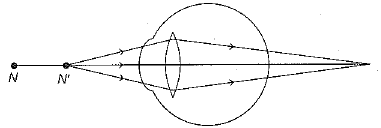
(a) Which defect of vision is represented in this case? Give reason for your answer.
(b) What could be the two causes of this defect?
(c) With the help of a diagram, show how this defect can be corrected by the use of a suitable lens.
Or
Explain the phenomenon of dispersion of white light through a glass prism, using suitable ray diagram. (5 Mark)
Ans: (i) Pupil is a small hole in the iris. They together control the amount of light entering the eye. In dim fight, pupil opens up completely due to expansion of iris muscles and in bright light it becomes very small due to contraction of iris muscles.
(ii) (a) This defect is hypermetropia or long-sightedness as the image of near point is formed beyond retina,
(b) The two causes of the defect are
- size of eye ball decreases.
- focal length of the lens increases.
(c) This defect can be corrected by using a convex lens of a appropriate focal length is as shown below.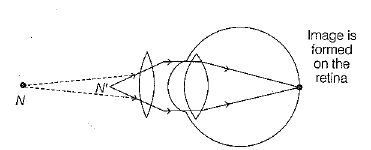
Or
When a white light ray passes through a prism, the white light is dispersed into its seven colour components by a prism and different colours of light bend through different angles with respect to the incident ray.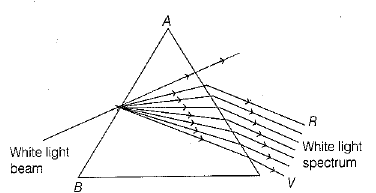
The red light bends the least, while the violet the most. Thus, the rays of each colour emerge along different paths and thus become distinct.
It is the band of distinct colours via violet, indigo, blue, green, yellow, orange and red (VIBGYOR).as shown in above figure is known as spectrum of white light.
Q.29. (a) Draw the diagram of female reproductive system and match and mark the part(s) :
(i) Where block is created surgically to prevent fertilisation.
(ii) Where CuT is inserted ?
(iii) Inside which condom can be placed.
(b) Why do more and more people prefer to use condoms ? What is the principle behind use of condoms ? (5 Mark)
Ans: (a) Female reproductive system -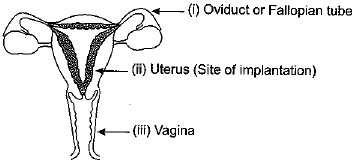
(b) More and more people prefer using condoms as they provide a convenient method for prevention of pregnancy. They can be easily worn by the male or the female partner, gives privacy to the user and also prevents spread of sexually transmitted diseases.
Principle behind use of condoms help create a mechanical barrier, preventing meeting of sperms and ovum.
Q.30. A student focused the image of a candle flame on a white screen by placing the flame at various distances from a convex lens. He noted his observations: (5 Mark)
(a) From the above table, find the focal length of lens without using lens formula.
(b) Which set of observations is incorrect and why?
(c) In which case the size of object and image will be same? Give reason for your answer.
Or
Account for the following:
(a) Part of the human eye that helps in changing the focal length of the eye lens.
(b) The condition resulting due to the eye lens becoming cloudy.
(c) The factors on which colour of the scattered white light depends.
(d) The range of vision of a normal eye.
(e) The sky appears dark to the astronauts in the space.
Ans:
(a) From the table of observation, it is clear that for u = 30, v = 30 cm. This means that both u and v must be equal to twice the focal length of the convex lens.
Focal length of the convex = 30/2 = 15 cm
(b) The observation (v) is incorrect. For this observation u = 15 = f, i.e., the object is at the focus and the image must be formed at infinity and not 70 cm.
(c) Since m = v/u, the size of the image will be equal to the size of the object, if v = u i.e., for the observation (iii).
Or
(a) Ciliary muscles.
(b) Cataract
(c) Air molecules, size of the dust particles and air pollutants in the atmosphere.
(d) From 25 cm to infinity.
(e) There is no atmosphere, hence no scattering of light.
|
80 videos|569 docs|80 tests
|
FAQs on Class 10 Science: CBSE Sample Question Paper (2019-20) - 6 - Science Class 10
| 1. What is the CBSE Sample Question Paper for Class 10 Science (2019-20)? |  |
| 2. What is the importance of solving CBSE sample question papers for Class 10 Science? |  |
| 3. How can solving CBSE sample question papers help in scoring better in the Class 10 Science exam? |  |
| 4. Is it necessary to solve the CBSE sample question papers for Class 10 Science multiple times? |  |
| 5. Are the CBSE sample question papers for Class 10 Science available online? |  |
















